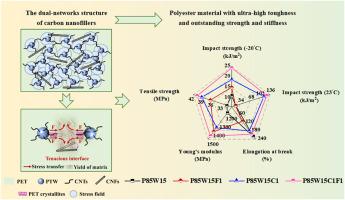Synchronously enhancing fracture toughness and mechanical strength of polyester blend composites via constructing dual-network structures of one-dimensional carbon nanofillers
IF 4.1
2区 化学
Q2 POLYMER SCIENCE
引用次数: 0
Abstract
It is challenging to achieve the trade-off between toughness, strength and stiffness with polyester blend composites for the expansion of their application in electronics, automobiles and other fields. Here, one-dimensional carbon nanofillers with different morphologies and sizes, including carbon nanofibers (CNFs) with larger diameter and straight morphology and carbon nanotubes (CNTs) with smaller diameter and coiled morphology, were introduced into polyethylene terephthalate/ethylene-butyl acrylate-glycidyl methacrylate copolymer (PET/PTW) blend composites, and the selective location of nanofillers was tailored by thermodynamic parameters and processing conditions. It was found that the dual-network structures of nanofillers was successfully constructed in blend composites, containing a CNTs network distributed at the interface of the blend and a CNFs network located in the PET matrix, respectively, which synchronously enhanced the toughness, strength and stiffness of the blend composite drastically. When the contents of CNFs and CNTs were both 1 wt%, the impact strength, Young's modulus and tensile strength of the quaternary blend composites were increased by 448.2, 22.8 and 29.1 %, separately, compared with those of the binary blend. The toughening mechanism was ascribed to the significant reduction of the matrix ligament thickness induced by the dual effects of compatibilization and preventing the aggregation of dispersed phase droplets of nanofillers. While the strengthening mechanisms were mainly ascribed to the construction of CNFs network in PET matrix and the promotion of CNTs on the crystallization of PET restricting the movement of matrix molecular segments. This work provides novel insights to manufacture the super-toughness and high-strength polyester blend composites.


求助全文
约1分钟内获得全文
求助全文
来源期刊

Polymer
化学-高分子科学
CiteScore
7.90
自引率
8.70%
发文量
959
审稿时长
32 days
期刊介绍:
Polymer is an interdisciplinary journal dedicated to publishing innovative and significant advances in Polymer Physics, Chemistry and Technology. We welcome submissions on polymer hybrids, nanocomposites, characterisation and self-assembly. Polymer also publishes work on the technological application of polymers in energy and optoelectronics.
The main scope is covered but not limited to the following core areas:
Polymer Materials
Nanocomposites and hybrid nanomaterials
Polymer blends, films, fibres, networks and porous materials
Physical Characterization
Characterisation, modelling and simulation* of molecular and materials properties in bulk, solution, and thin films
Polymer Engineering
Advanced multiscale processing methods
Polymer Synthesis, Modification and Self-assembly
Including designer polymer architectures, mechanisms and kinetics, and supramolecular polymerization
Technological Applications
Polymers for energy generation and storage
Polymer membranes for separation technology
Polymers for opto- and microelectronics.
 求助内容:
求助内容: 应助结果提醒方式:
应助结果提醒方式:


